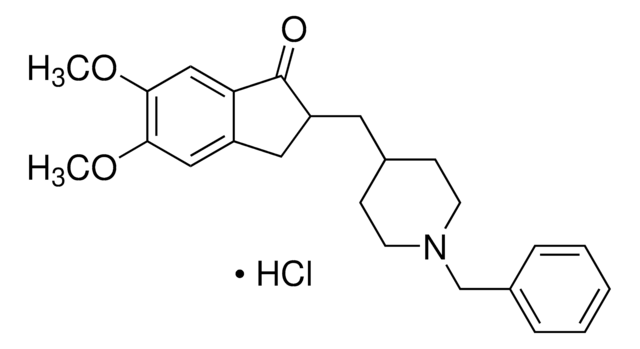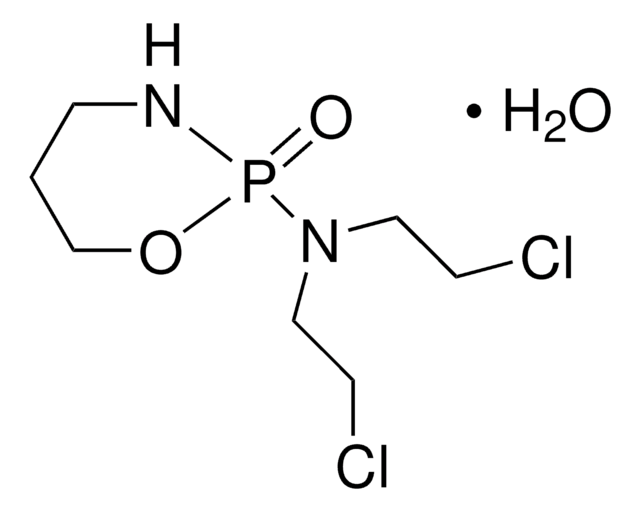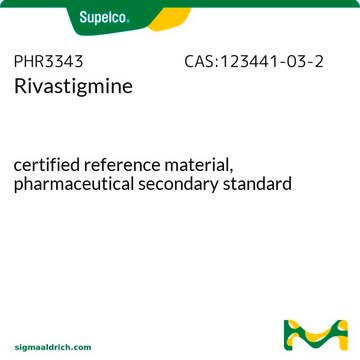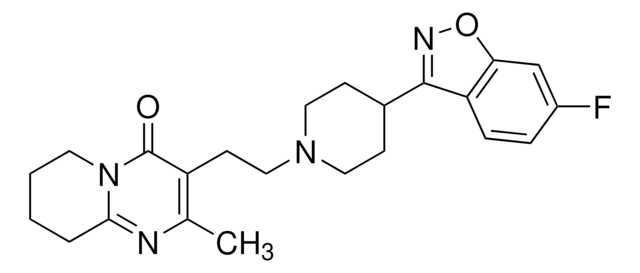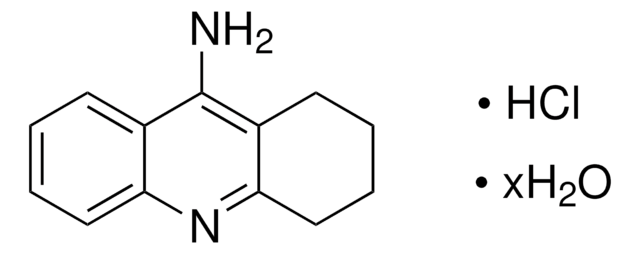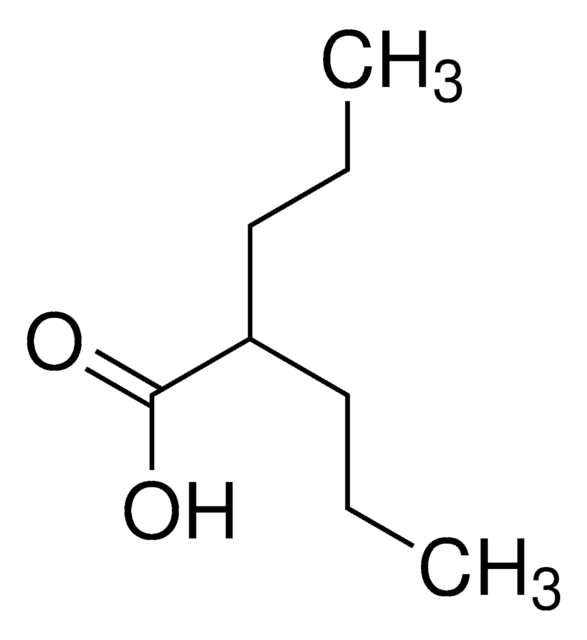1224981
USP
Donepezil -hydrochlorid
United States Pharmacopeia (USP) Reference Standard
Synonym(e):
(±)-2-[(1-Benzyl-4-piperidyl)-methyl]-5,6-dimethoxy-1-indanon -hydrochlorid, 2,3-Dihydro-5,6-dimethoxy-2-{[1-(phenylmethyl)-4-piperidinyl]-methyl}-1H-inden-1-on
About This Item
Empfohlene Produkte
Qualität
pharmaceutical primary standard
API-Familie
donepezil
Hersteller/Markenname
USP
Anwendung(en)
pharmaceutical (small molecule)
Format
neat
InChI
1S/C24H29NO3.ClH/c1-27-22-14-19-13-20(24(26)21(19)15-23(22)28-2)12-17-8-10-25(11-9-17)16-18-6-4-3-5-7-18;/h3-7,14-15,17,20H,8-13,16H2,1-2H3;1H
InChIKey
XWAIAVWHZJNZQQ-UHFFFAOYSA-N
Suchen Sie nach ähnlichen Produkten? Aufrufen Leitfaden zum Produktvergleich
Allgemeine Beschreibung
Anwendung
- Novel tacrine-donepezil hybrids for Alzheimer′s treatment: Research has led to the development of new tacrine-donepezil hybrid compounds targeting Alzheimer′s disease, offering enhanced bioactivity and potential therapeutic benefits. These hybrids demonstrate multifunctional approaches in addressing neurodegenerative disorders by combining the acetylcholinesterase inhibitory effects of donepezil with the neuroprotective properties of tacrine (Bayraktar et al., 2024).
- Role of oligodendrocytes in Alzheimer′s disease: A study explores the involvement of oligodendrocytes in Alzheimer′s pathogenesis, highlighting potential mechanisms where donepezil could be implicated in modulating neurodegenerative processes. This research underscores the broader applicability of donepezil in understanding and potentially treating Alzheimer′s disease (Wang et al., 2024).
- Shenghui decoction′s neuroprotective effects: Investigating traditional therapies, this study assesses the neuroprotective effects of Shenghui decoction in an Alzheimer′s disease model. Donepezil′s role in this context is compared, contributing to broader insights into potential integrative treatments for neurodegenerative diseases (Lu et al., 2024).
- Electrochemical sensors for Alzheimer′s drug analysis: The development of electrochemical acetylcholinesterase sensors designed for the detection and study of anti-Alzheimer drugs like donepezil underscores its importance in research and therapeutic monitoring. This advancement supports the precise administration and study of donepezil in clinical settings (Ivanov et al., 2024).
- Modulating neurodegeneration with donepezil: A study on the combined effects of endothelin receptor agonist IRL-1620 with donepezil in an amyloid-β induced model of neurodegeneration in rats, expands our understanding of donepezil′s therapeutic potential beyond traditional applications, suggesting its utility in complex therapeutic regimes (Mahajan et al., 2024).
Hinweis zur Analyse
Sonstige Hinweise
Ähnliches Produkt
Signalwort
Danger
H-Sätze
Gefahreneinstufungen
Acute Tox. 2 Oral - Eye Irrit. 2
Lagerklassenschlüssel
6.1A - Combustible, acute toxic Cat. 1 and 2 / very toxic hazardous materials
WGK
WGK 3
Flammpunkt (°F)
Not applicable
Flammpunkt (°C)
Not applicable
Analysenzertifikate (COA)
Suchen Sie nach Analysenzertifikate (COA), indem Sie die Lot-/Chargennummer des Produkts eingeben. Lot- und Chargennummern sind auf dem Produktetikett hinter den Wörtern ‘Lot’ oder ‘Batch’ (Lot oder Charge) zu finden.
Besitzen Sie dieses Produkt bereits?
In der Dokumentenbibliothek finden Sie die Dokumentation zu den Produkten, die Sie kürzlich erworben haben.
Kunden haben sich ebenfalls angesehen
Unser Team von Wissenschaftlern verfügt über Erfahrung in allen Forschungsbereichen einschließlich Life Science, Materialwissenschaften, chemischer Synthese, Chromatographie, Analytik und vielen mehr..
Setzen Sie sich mit dem technischen Dienst in Verbindung.